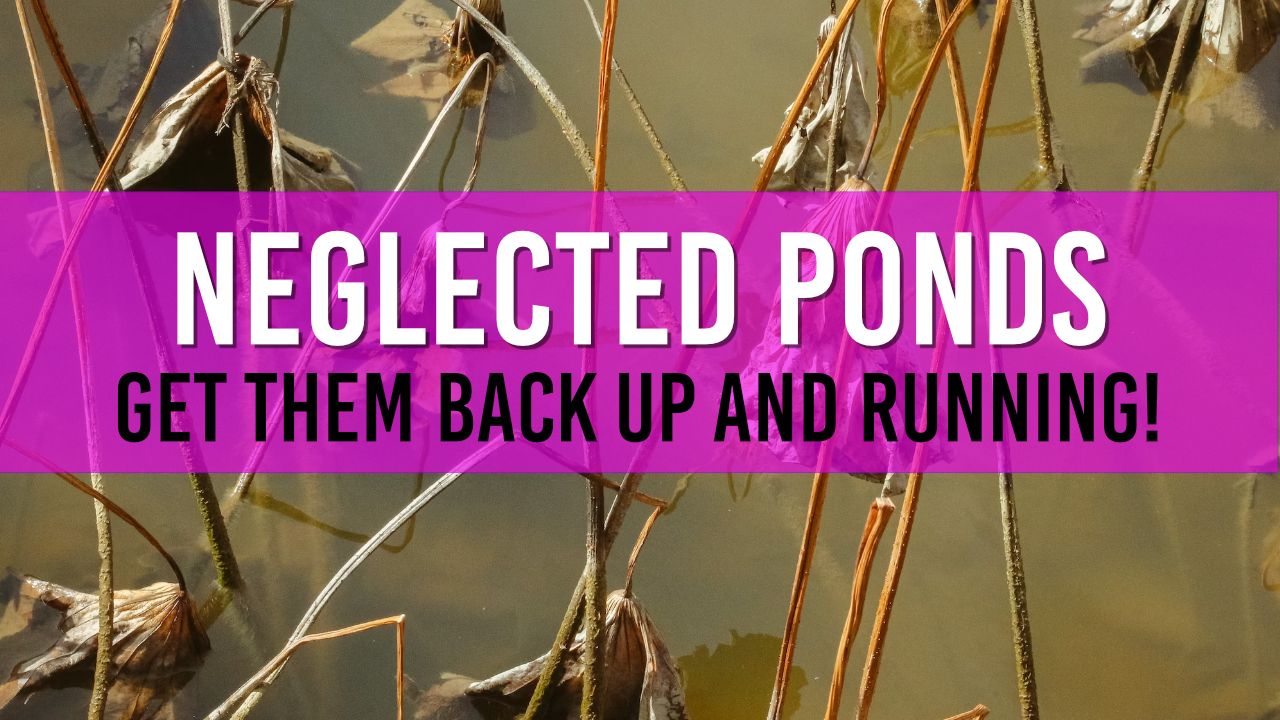Dealing with a Neglected Pond
Neglected ponds will not only start to smell, but eventually will harm your pond fish and other aquatic life. You need to take action by cleaning your filtration system and performing a water change as soon as possible.

Table of Contents
Have you recently taken possession of a property with a pond that's seen better days? Or maybe you've been busy and overlooked your pond maintenance? Here’s how to breathe life back into a struggling garden feature.
Recognizing a Neglected Pond: Key Indicators
- Murky Water: Clear water is a sign of a healthy pond. Murky or discoloured water can be a warning signal.
- Unpleasant Odour: A foul stench emanating from the pond often indicates stagnation or decay.
- Fish Distress: If fish frequently come to the surface, gasping for air, it’s a sign they’re not getting enough oxygen.
- Non-Functioning Features: Waterfalls or other water features that have stopped working can point to pump or filtration issues.
I promise I cleaned the filters before my Holiday
A friend recently reached out to me after coming back from a vacation. The unpleasant smell from his pond was hard to ignore, and his once active waterfall was silent.
His fish were lethargic and uninterested in food, and without any water movement his pond had become the new hotspot for Mosquitos.
Despite his insistence that he had cleaned the filters just before his trip, he couldn't work out why everything had stopped - surely the pump must be faulty?
Prior to calling me, he had turned off the electricity to his pond and cleaned the pump and cage, only for nothing to change.
I asked what type of clean he performed on his filter sponges and he said he used the back flow method (some filter boxes can be switched to clean the filter sponges and expel dirty water away from the pond).
It was time for me to get my hands dirty!
Checking the Pump
Despite the clean exterior, the inside of the pump would hold a different story. My suspicions were confirmed when I found blanket weed entangled around the pump impeller, preventing the motor from spinning and therefore obstructing water flow.

After carefully removing the blanket weed with some long tweezers and ensuring the pump impeller was free-moving, I returned the pump to the pond and switched the electricity back on hoping my 5 minute fix would suffice.
Unfortunately, nothing happened. To ensure the pump was functioning, I partially lifted it out of the water while powered on and to my joy heard the pump working - which meant there was either a blockage or the filter sponges needed some TLC.
Attacking the Filter Sponges
As with most ponds, the pump fed water to the filter boxes, so that was my next target for attack.
Once again turning off the electricity I carefully unclipped the filter and braced myself for wet feet (pond owners with pressurized filter boxes will understand!).
After some gentle jiggling the top of the filter box came away and the smell of stale rotten water hit me like a train. I think I found the problem.

If you've not read my article on how to clean pond filters, I suggest giving it a quick read as it goes into lots of detail on how I personally clean blocked filter sponges.
The general process is:
- Remove the filters 1 by 1 (making sure you keep track of what goes where)
- Place the dirty filters in a drain
- Spray with a hose pipe
- Squeeze the filters until the water runs clear
- Use a pond vac / wet vac to get the last bits of dirty and debris
- Clean any bio-media of sludge/mud
- Rinse and clean the filter box with a hose pipe to remove any sludge
- Replace all items in the order they came out ✔
2 hours in, covered in pond sludge, stinking like a swamp monster I reconnected the pipes and turned on the pump expecting to hear the sound of water filling up.....NOTHING!
What else could be stopping the water flow?
I knew the pump was ok, I knew the filter box was clean... yet nothing was happening.
It then dawned on me... pipes!
It's often overlooked by Pond Owners to clean their pond pipes. Generally speaking, a well maintained pond will never have an issue with blocked pipes, however if water is not flowing, it allows for sludge/mud to build up inside the pipes eventually causing a blockage - especially in the lower bends of your pipes.
Cleaning Pond Filter Pipes
Once again turning off the electricity, I removed the pipe that connected the pond pump to the filter box and carried it over to the drain (which was still caked in filter box sludge).

Using a garden cane I poked the hole and gave it a good shake 🙃, and eventually managed to dislodge a huge lump of sludge which splattered over my friends wall (and kitchen window).
Then using a hose pipe, cleaned all the inside of the pipe and reconnected to the pond pump and filter box.
I switched on the electricity to the pond pump and with tears of joy, heard the filter box being filled with water...and after 2 minutes the waterfall kicked in!
Neglected Ponds DO need a Water Change
We were unsure as to how long the pond water had been stagnant, however the smell alone was enough for me to suggest that we should perform a fairly decent water change.
I've already discussed the benefits of pond water changes, however below are my top 10 reasons why you should perform a water change - especially if the pond has been neglected.
- Enhanced Clarity: Fresh water improves pond transparency.
- Contaminant Reduction: Dilutes toxins and pollutants.
- Nutrient Regulation: Prevents harmful algae blooms.
- Stable pH: Helps maintain consistent pH levels.
- Mineral Replenishment: Introduces vital minerals for fish.
- Oxygen Boost: Fresh water elevates oxygen levels.
- Sludge Management: Reduces bottom sediment build-up.
- Healthier Fish: Reduces fish stress and improves vitality.
- Beneficial Bacteria: Bolsters natural waste breakdown.
- Owner Satisfaction: A healthier pond offers greater enjoyment.
So how could all of this has been prevented?
Prevention is always a better approach when it comes to your garden pond, but sometimes life does get in the way and we're left to spend a lot longer fixing an issue than the total time it would have taken to "keep on top of things".
I don't have any issue with Pond Owners who use the back washing of filter boxes - however we've all fallen victim to leaving it "too long" before using the self clean option.
I explained to my friend that even 5 minutes every week of using the self clean option will help ensure his filters don't get completely blocked.
He also now knows how to clean his pump impeller, making it part of his weekly routine to check.
If you have any tips, suggestions or questions, please leave a comment below - I'm off to get a shower!

